High-Resolution Flood Monitoring Based on Advanced Statistical Modeling of Sentinel-1 Multi-Temporal Stacks
Abstract
1. Introduction
2. Materials and Methods
2.1. Study Area
2.2. Major Flood Events from 2014
2.3. Sentinel-1 Data
2.4. Bayesian Framework
2.5. Temporal Modelling
3. Results
3.1. Flood Map Analysis and Methodology Comparison for the Events in Table 1
3.2. Flood Map Evaluation
4. Discussion
- Not all the events in Table 1 are clearly identifiable in the plots; in fact, we can only spot 1: the March 2016 event (in red). This may be due to the fact that the events have limited extensions and also because the acquisitions do not correspond to the peak phases of the events, which is the case for the 14 March 2016 scene. As can also be seen from Figure S2, the maps for the other three dates do not show any relevant flood extents, for the whole area (satellite acquisitions 1 or 2 days after the peak of the event). On the other hand, the methodology makes it possible to identify minor events not easily found in the literature.
- Of all the events in Table 1, only for the one on 14 March 2016 is there a high peak related to the flood extent matching with a rainfall peak, and this occurs only on the plot for subset region n°1, located near the Pisticci Scalo area. A slightly lower peak is visible on the plot for subarea n. 2, while for the third region, no orange peak is visible in correspondence to peaks in the rainfall data.
- The only two dates where we find flood extent peaks on all three subareas are 22 March 2018 and 24 November 2019. For what concerns the former, in the morning of 22 March 2018, the entire Basilicata region was affected by a severe cold storm, resulting in widespread snowfall [73,74]. Since the local acquisition time of Sentinel 1 on that date is 16:47, when the snowfall event was finished and practically all the snow had melted, the peaks visible on that date on all three subareas (numbered 3, 4, and 2, respectively, in the three plots) could be due to the extensive water pools left after snow melting. Regarding the date of 24 November 2019, we have clear agreement with rainfall peaks in all three subsets.
- Considerable variation can be seen in the detected flood extents which result after each rainfall event, either within each subarea or among different subareas for the same events. In particular, not all the strongest rainfall events correspond to detected peaks of flood extents, and vice versa. This heterogeneity arises in part from the fact that the subareas are located on different river basins (Basento, Agri, Sinni), which respond differently to rainfall, both in time and in space [75]. For instance, the part of the Basento river falling within subset n°1 crosses a hilly area, with slopes oriented towards the MCP. The second subset is located in the third section of the Agri river, where the slopes gradually decrease and the alluvial plain of the watercourse widens considerably. The third subset, on the other hand, is in the final part of the Sinni river, in the MCP; although a complete geomorphological and/or hydrological analysis of such features is out of the scope of the present work, it is clear that the kind of information made available by the analysis of the produced flood probability map stacks is of unprecedented resolution, so that it could constitute a new and precious tool of analysis of the landscape responses to meteorological events, a crucial task in, e.g., climate change studies.
5. Conclusions
Supplementary Materials
Author Contributions
Funding
Data Availability Statement
Acknowledgments
Conflicts of Interest
References
- Brémond, P.; Grelot, F.; Agenais, A.-L. Review Article: Economic Evaluation of Flood Damage to Agriculture—Review and Analysis of Existing Methods. Nat. Hazards Earth Syst. Sci. 2013, 13, 2493–2512. [Google Scholar] [CrossRef]
- Willner, S.N.; Levermann, A.; Zhao, F.; Frieler, K. Adaptation Required to Preserve Future High-End River Flood Risk at Present Levels. Sci. Adv. 2018, 4, eaao1914. [Google Scholar] [CrossRef] [PubMed]
- Dottori, F.; Szewczyk, W.; Ciscar, J.-C.; Zhao, F.; Alfieri, L.; Hirabayashi, Y.; Bianchi, A.; Mongelli, I.; Frieler, K.; Betts, R.A.; et al. Increased Human and Economic Losses from River Flooding with Anthropogenic Warming. Nat. Clim Chang. 2018, 8, 781–786. [Google Scholar] [CrossRef]
- Douville, H.; Raghavan, K.; Renwick, J.; Allan, R.P.; Arias, P.A.; Barlow, M.; Cerezo-Mota, R.; Cherchi, A.; Gan, T.Y.; Gergis, J.; et al. 2021: Water Cycle Changes. In Climate Change 2021: The Physical Science Basis; IPCC: Geneva, Switzerland, 2021. [Google Scholar]
- Tariq, M.A.U.R.; Farooq, R.; van de Giesen, N. A Critical Review of Flood Risk Management and the Selection of Suitable Measures. Appl. Sci. 2020, 10, 8752. [Google Scholar] [CrossRef]
- Liang, S.; Wang, J. (Eds.) A Systematic View of Remote Sensing. In Advanced Remote Sensing, 2nd ed.; Academic Press: Cambridge, MA, USA, 2020; pp. 1–57. ISBN 978-0-12-815826-5. [Google Scholar]
- Kuntla, S.K. An Era of Sentinels in Flood Management: Potential of Sentinel-1, -2, and -3 Satellites for Effective Flood Management. Open Geosci. 2021, 13, 1616–1642. [Google Scholar] [CrossRef]
- DeVries, B.; Huang, C.; Armston, J.; Huang, W.; Jones, J.W.; Lang, M.W. Rapid and Robust Monitoring of Flood Events Using Sentinel-1 and Landsat Data on the Google Earth Engine. Remote Sens. Environ. 2020, 240, 111664. [Google Scholar] [CrossRef]
- Colacicco, R.; Refice, A.; Nutricato, R.; D’Addabbo, A.; Nitti, D.O.; Capolongo, D. High Spatial and Temporal Resolution Flood Monitoring through Integration of Multisensor Remotely Sensed Data and Google Earth Engine Processing. In Proceedings of the Copernicus Meetings, Vienna, Austria, 23–27 May 2022. [Google Scholar]
- Fattore, C.; Abate, N.; Faridani, F.; Masini, N.; Lasaponara, R. Google Earth Engine as Multi-Sensor Open-Source Tool for Supporting the Preservation of Archaeological Areas: The Case Study of Flood and Fire Mapping in Metaponto, Italy. Sensors 2021, 21, 1791. [Google Scholar] [CrossRef]
- Wagner, W.; Bauer-Marschallinger, B.; Navacchi, C.; Reuß, F.; Cao, S.; Reimer, C.; Schramm, M.; Briese, C. A Sentinel-1 Backscatter Datacube for Global Land Monitoring Applications. Remote Sens. 2021, 13, 4622. [Google Scholar] [CrossRef]
- D’Addabbo, A.; Refice, A.; Capolongo, D.; Pasquariello, G.; Manfreda, S. Data Fusion Through Bayesian Methods for Flood Monitoring from Remotely Sensed Data. In Flood Monitoring through Remote Sensing; Refice, A., D’Addabbo, A., Capolongo, D., Eds.; Springer Remote Sensing/Photogrammetry; Springer International Publishing: Cham, Switzerland, 2018; pp. 181–208. ISBN 978-3-319-63959-8. [Google Scholar]
- Pierdicca, N.; Chini, M.; Pulvirenti, L.; Macina, F. Integrating Physical and Topographic Information Into a Fuzzy Scheme to Map Flooded Area by SAR. Sensors 2008, 8, 4151–4164. [Google Scholar] [CrossRef]
- Martinis, S.; Twele, A. A Hierarchical Spatio-Temporal Markov Model for Improved Flood Mapping Using Multi-Temporal X-Band SAR Data. Remote Sens. 2010, 2, 2240–2258. [Google Scholar] [CrossRef]
- Han, S.; Coulibaly, P. Bayesian Flood Forecasting Methods: A Review. J. Hydrol. 2017, 551, 340–351. [Google Scholar] [CrossRef]
- Lin, Y.N.; Yun, S.-H.; Bhardwaj, A.; Hill, E.M. Urban Flood Detection with Sentinel-1 Multi-Temporal Synthetic Aperture Radar (SAR) Observations in a Bayesian Framework: A Case Study for Hurricane Matthew. Remote Sens. 2019, 11, 1778. [Google Scholar] [CrossRef]
- Pourreza-Bilondi, M.; Samadi, S.Z.; Akhoond-Ali, A.-M.; Ghahraman, B. Reliability of Semiarid Flash Flood Modeling Using Bayesian Framework. J. Hydrol. Eng. 2017, 22, 05016039. [Google Scholar] [CrossRef]
- D’Addabbo, A.; Refice, A.; Pasquariello, G.; Bovenga, F.; Chiaradia, M.T.; Nitti, D.O. A Bayesian Network for Flood Detection. In Proceedings of the 2014 IEEE Geoscience and Remote Sensing Symposium, Quebec City, QU, Canada, 13–18 July 2014; pp. 3594–3597. [Google Scholar]
- D’Addabbo, A.; Refice, A.; Pasquariello, G.; Lovergine, F.P.; Capolongo, D.; Manfreda, S. A Bayesian Network for Flood Detection Combining SAR Imagery and Ancillary Data. IEEE Trans. Geosci. Remote Sens. 2016, 54, 3612–3625. [Google Scholar] [CrossRef]
- Giustarini, L.; Hostache, R.; Kavetski, D.; Chini, M.; Corato, G.; Schlaffer, S.; Matgen, P. Probabilistic Flood Mapping Using Synthetic Aperture Radar Data. IEEE Trans. Geosci. Remote Sens. 2016, 54, 6958–6969. [Google Scholar] [CrossRef]
- D’Addabbo, A.; Refice, A.; Lovergine, F.P.; Pasquariello, G. DAFNE: A Matlab Toolbox for Bayesian Multi-Source Remote Sensing and Ancillary Data Fusion, with Application to Flood Mapping. Comput. Geosci. 2018, 112, 64–75. [Google Scholar] [CrossRef]
- Refice, A.; D’Addabbo, A.; Lovergine, F.P.; Bovenga, F.; Nutricato, R.; Nitti, D.O. Improving Flood Monitoring Through Advanced Modeling of Sentinel-1 Multi-Temporal Stacks. In Proceedings of the IGARSS 2022–2022 IEEE International Geoscience and Remote Sensing Symposium, Kuala Lumpur, Malaysia, 17–22 July 2022; pp. 5881–5884. [Google Scholar]
- Bauer-Marschallinger, B.; Cao, S.; Tupas, M.E.; Roth, F.; Navacchi, C.; Melzer, T.; Freeman, V.; Wagner, W. Satellite-Based Flood Mapping through Bayesian Inference from a Sentinel-1 SAR Datacube. Remote Sens. 2022, 14, 3673. [Google Scholar] [CrossRef]
- Matgen, P.; Montanari, M.; Hostache, R.; Pfister, L.; Hoffmann, L.; Plaza, D.; Pauwels, V.R.N.; De Lannoy, G.J.M.; De Keyser, R.; Savenije, H.H.G. Towards the Sequential Assimilation of SAR-Derived Water Stages into Hydraulic Models Using the Particle Filter: Proof of Concept. Hydrol. Earth Syst. Sci. 2010, 14, 1773–1785. [Google Scholar] [CrossRef]
- Chini, M.; Pelich, R.; Li, Y.; Hostache, R.; Zhao, J.; Di Mauro, C.; Matgen, P. Sar-Based Flood Mapping, Where We Are and Future Challenges. In Proceedings of the 2021 IEEE International Geoscience and Remote Sensing Symposium IGARSS, Brussels, Belgium, 11–16 July 2021; pp. 884–886. [Google Scholar]
- Long, S.; Fatoyinbo, T.E.; Policelli, F. Flood Extent Mapping for Namibia Using Change Detection and Thresholding with SAR. Environ. Res. Lett. 2014, 9, 035002. [Google Scholar] [CrossRef]
- Westerhoff, R.S.; Kleuskens, M.P.H.; Winsemius, H.C.; Huizinga, H.J.; Brakenridge, G.R.; Bishop, C. Automated Global Water Mapping Based on Wide-Swath Orbital Synthetic-Aperture Radar. Hydrol. Earth Syst. Sci. 2013, 17, 651–663. [Google Scholar] [CrossRef]
- Pulvirenti, L.; Chini, M.; Pierdicca, N.; Guerriero, L.; Ferrazzoli, P. Flood Monitoring Using Multi-Temporal COSMO-SkyMed Data: Image Segmentation and Signature Interpretation. Remote Sens. Environ. 2011, 115, 990–1002. [Google Scholar] [CrossRef]
- Schlaffer, S.; Matgen, P.; Hollaus, M.; Wagner, W. Flood Detection from Multi-Temporal SAR Data Using Harmonic Analysis and Change Detection. Int. J. Appl. Earth Obs. Geoinf. 2015, 38, 15–24. [Google Scholar] [CrossRef]
- Wagner, W.; Freeman, V.; Cao, S.; Matgen, P.; Chini, M.; Salamon, P.; McCormick, N.; Martinis, S.; Bauer-Marschallinger, B.; Navacchi, C.; et al. Data Processing Architectures for Monitoring Floods Using Sentinel-1. ISPRS Ann. Photogramm. Remote Sens. Spat. Inf. Sci. 2020, V-3–2020, 641–648. [Google Scholar] [CrossRef]
- Tsyganskaya, V.; Martinis, S.; Twele, A.; Cao, W.; Schmitt, A.; Marzahn, P.; Ludwig, R. A Fuzzy Logic-Based Approach for the Detection of Flooded Vegetation by Means of Synthetic Aperture Radar Data. Int. Arch. Photogramm. Remote Sens. Spat. Inf. Sci. 2016, XLI-B7, 371–378. [Google Scholar] [CrossRef]
- Tupas, M.E.; Roth, F.; Bauer-Marschallinger, B.; Wagner, W. An Intercomparison of Sentinel-1 Based Change Detection Algorithms for Flood Mapping. Remote Sens. 2023, 15, 1200. [Google Scholar] [CrossRef]
- Verbesselt, J.; Zeileis, A.; Herold, M. Near Real-Time Disturbance Detection Using Satellite Image Time Series. Remote Sens. Environ. 2012, 123, 98–108. [Google Scholar] [CrossRef]
- Tupas, M.; Navacchi, C.; Roth, F.; Bauer-Marschallinger, B.; Reuß, F.; Wagner, W. Computing global harmonic parameters for flood mapping using tu wien’s sar datacube software stack. Int. Arch. Photogramm. Remote Sens. Spat. Inf. Sci. 2022, XLVIII-4-W1-2022, 495–502. [Google Scholar] [CrossRef]
- Tropeano, M.; Cilumbriello, A.; Sabato, L.; Gallicchio, S.; Grippa, A.; Longhitano, S.G.; Bianca, M.; Gallipoli, M.R.; Mucciarelli, M.; Spilotro, G. Surface and Subsurface of the Metaponto Coastal Plain (Gulf of Taranto—Southern Italy): Present-Day- vs LGM-Landscape. Geomorphology 2013, 203, 115–131. [Google Scholar] [CrossRef]
- Bentivenga, M.; Giano, S.I.; Piccarreta, M. Recent Increase of Flood Frequency in the Ionian Belt of Basilicata Region, Southern Italy: Human or Climatic Changes? Water 2020, 12, 2062. [Google Scholar] [CrossRef]
- Masciopinto, C.; Polemio, M. La ricarica naturale della falda idrica dell’acquifero costiero di Metaponto. Quad. Di Geol. Appl. 1994; in press. [Google Scholar]
- Piccarreta, M.; Lazzari, M.; Pasini, A. Trends in Daily Temperature Extremes over the Basilicata Region (Southern Italy) from 1951 to 2010 in a Mediterranean Climatic Context. Int. J. Climatol. 2015, 35, 1964–1975. [Google Scholar] [CrossRef]
- Schiattarella, M. Inquadramento Geografico e Geomorfologico. In Basilicata; Guide Geologiche Regionali; Società Geologica Italiana – Litotipografia Alcione: Trentino, Italy, 2020. [Google Scholar]
- Bhattacharya, J.P.; Giosan, L. Wave-Influenced Deltas: Geomorphological Implications for Facies Reconstruction. Sedimentology 2003, 50, 187–210. [Google Scholar] [CrossRef]
- Sabato, L.; Longhitano, S.G.; Gioia, D.; Cilumbriello, A.; Spalluto, L. Sedimentological and Morpho-Evolution Maps of the ‘ Bosco Pantano Di Policoro ’ Coastal System (Gulf of Taranto, Southern Italy). J. Maps 2012, 8, 304–311. [Google Scholar] [CrossRef]
- Gioia, D.; Bavusi, M.; Di Leo, P.; Giammatteo, T.; Schiattarella, M. Geoarchaeology and Geomorphology of the Metaponto Area, Ionian Coastal Belt, Italy. J. Maps 2020, 16, 117–125. [Google Scholar] [CrossRef]
- Lapietra, I.; Rizzo, A.; Colacicco, R.; Dellino, P.; Capolongo, D. Evaluation of Social Vulnerability to Flood Hazard in Basilicata Region (Southern Italy). Water 2023, 15, 1175. [Google Scholar] [CrossRef]
- Capolongo, D.; Pennetta, L.; Piccarreta, M.; Fallacara, G.; Boenzi, F. Spatial and Temporal Variations in Soil Erosion and Deposition Due to Land-Levelling in a Semi-Arid Area of Basilicata (Southern Italy). Earth Surf. Process. Landf. 2008, 33, 364–379. [Google Scholar] [CrossRef]
- Boenzi, F.; Caldara, M.; Capolongo, D.; Dellino, P.; Piccarreta, M.; Simone, O. Late Pleistocene–Holocene Landscape Evolution in Fossa Bradanica, Basilicata (Southern Italy). Geomorphology 2008, 102, 297–306. [Google Scholar] [CrossRef]
- Bentivenga, M.; Capolongo, D.; Palladino, G.; Piccarreta, M. Geomorphological Map of the Area between Craco and Pisticci (Basilicata, Italy). J. Maps 2015, 11, 267–277. [Google Scholar] [CrossRef]
- Gallicchio, S.; Colacicco, R.; Capolongo, D.; Girone, A.; Maiorano, P.; Marino, M.; Ciaranfi, N. Geological Features of the Special Nature Reserve of Montalbano Jonico Badlands (Basilicata, Southern Italy). J. Maps 2023, 19, 2179435. [Google Scholar] [CrossRef]
- Elfadaly, A.; Abutaleb, K.; Naguib, D.M.; Lasaponara, R. Detecting the Environmental Risk on the Archaeological Sites Using Satellite Imagery in Basilicata Region, Italy. Egypt. J. Remote Sens. Space Sci. 2022, 25, 181–193. [Google Scholar] [CrossRef]
- Piccarreta, M.; Pasini, A.; Capolongo, D.; Lazzari, M. Changes in Daily Precipitation Extremes in the Mediterranean from 1951 to 2010: The Basilicata Region, Southern Italy. Int. J. Climatol. 2013, 33, 3229–3248. [Google Scholar] [CrossRef]
- Dal Sasso, S.F.; Manfreda, S.; Capparelli, G.; Versace, P.; Samela, C.; Spilotro, G.; Fiorentino, M. La Pericolosità Idraulica e Geologica Della Regione Basilicata. L’Acqua 2017, 3, 77–85. [Google Scholar]
- Manfreda, S.; Sole, A.; De Costanzo, G. Le precipitazioni estreme in Basilicata; Universosud Edizioni: Potenza, Italy, 2015. [Google Scholar]
- EvAlMet—Eventi Alluvionali e precipitazioni meteoriche eccezionali del Metapontino’. Available online: http://www.evalmet.it/ (accessed on 8 April 2023).
- Centro Funzionale Basilicata. Report Idrologici. Available online: http://www.centrofunzionalebasilicata.it/it/report-idrologici.php (accessed on 8 April 2023).
- Filippo Mele Blog. Available online: https://filippomele.blogspot.com/ (accessed on 8 April 2023).
- La Gazzetta del Mezzogiorno. Available online: https://lagazzettadelmezzogiorno.it/ (accessed on 8 April 2023).
- Osservatorio Meteo Lucano. Available online: http://osservatoriometeolucano.altervista.org/blog/ (accessed on 8 April 2023).
- YouTube. Available online: https://www.youtube.com/results?search_query=alluvioni+basilicata (accessed on 8 April 2023).
- Potin, P.; Bargellini, P.; Laur, H.; Rosich, B.; Schmuck, S. Sentinel-1 Mission Operations Concept. In Proceedings of the 2012 IEEE International Geoscience and Remote Sensing Symposium, Munich, Germany, 22–27 July 2012; pp. 1745–1748. [Google Scholar]
- Lee, J.-S. Speckle Analysis and Smoothing of Synthetic Aperture Radar Images. Comput. Graph. Image Process. 1981, 17, 24–32. [Google Scholar] [CrossRef]
- Dabov, K.; Foi, A.; Katkovnik, V.; Egiazarian, K. Image Denoising by Sparse 3-D Transform-Domain Collaborative Filtering. IEEE Trans. Image Process. 2007, 16, 2080–2095. [Google Scholar] [CrossRef] [PubMed]
- Deledalle, C.-A.; Denis, L.; Tabti, S.; Tupin, F. MuLoG, or How to Apply Gaussian Denoisers to Multi-Channel SAR Speckle Reduction? IEEE Trans. Image Process. 2017, 26, 4389–4403. [Google Scholar] [CrossRef] [PubMed]
- Deledalle, C.-A.; Denis, L.; Tupin, F. Speckle Reduction in Matrix-Log Domain for Synthetic Aperture Radar Imaging. J. Math. Imaging Vis. 2022, 64, 298–320. [Google Scholar] [CrossRef]
- Schlaffer, S.; Chini, M.; Giustarini, L.; Matgen, P. Probabilistic Mapping of Flood-Induced Backscatter Changes in SAR Time Series. Int. J. Appl. Earth Obs. Geoinf. 2017, 56, 77–87. [Google Scholar] [CrossRef]
- Nobre, A.D.; Cuartas, L.A.; Hodnett, M.; Rennó, C.D.; Rodrigues, G.; Silveira, A.; Waterloo, M.; Saleska, S. Height Above the Nearest Drainage—A Hydrologically Relevant New Terrain Model. J. Hydrol. 2011, 404, 13–29. [Google Scholar] [CrossRef]
- Tinitaly Digital Elevation Model. Istituto Nazionale di Geofisica e Vulcanologia. Available online: https://tinitaly.pi.ingv.it/ (accessed on 8 April 2023).
- Rasmussen, C.E.; Williams, C.K.I. Gaussian Processes for Machine Learning; The MIT Press: Cambridge, MA, USA, 2006. [Google Scholar]
- Camps-Valls, G.; Verrelst, J.; Munoz-Mari, J.; Laparra, V.; Mateo-Jimenez, F.; Gomez-Dans, J. A Survey on Gaussian Processes for Earth-Observation Data Analysis: A Comprehensive Investigation. IEEE Geosci. Remote Sens. Mag. 2016, 4, 58–78. [Google Scholar] [CrossRef]
- Centro Funzionale Basilicata. Report Evento Marzo. 2018. Available online: http://www.centrofunzionalebasilicata.it/ew/ew_pdf/r/-Report_evento_marzo%202016.pdf (accessed on 18 April 2023).
- DJI Inspire 2. Available online: https://www.dji.com/it/inspire-2/info#specs (accessed on 1 September 2023).
- DJI Zenmuse X5. Available online: https://www.dji.com/it/zenmuse-x5s/info#specs (accessed on 1 September 2023).
- Eltner, A.; Sofia, G. Structure from motion photogrammetric technique. In Developments in Earth Surface Processes; Elsevier: Amsterdam, The Netherlands, 2020; Volume 23, pp. 1–24. [Google Scholar]
- Agenzia Lucana di Sviluppo e di Innovazione in Agricoltura (ALSIA). Available online: https://www.alsia.it/opencms/opencms (accessed on 8 April 2023).
- Centro Funzionale Basilicata. Bollettino Criticità. Available online: http://centrofunzionalebasilicata.it/ew/ew_pdf/a/Bollettino_Criticita_Regione_-Basilicata_22_03_2018.pdf (accessed on 1 May 2023).
- Sky TG24. Available online: https://tg24.sky.it/cronaca/¬2018/03/22/maltempo-neve-potenza--basilicata-foto#00 (accessed on 1 May 2023).
- Autorità di Bacino Della Basilicata (AdB). Available online: http://www.adb.basilicata.it/adb/risorseidriche/idrografico.asp (accessed on 31 May 2023).
- Stanton, S.; Maddox, W.; Delbridge, I.; Wilson, A.G. Kernel Interpolation for Scalable Online Gaussian Processes. In Proceedings of the 24th International Conference on Artificial Intelligence and Statistics, Virtual, 13–15 April 2021; pp. 3133–3141. [Google Scholar]
- Basilicata Magazine. Available online: https://www.basilicatamagazine.it/farepisticci-su-dissesto-idrogeologico/ (accessed on 8 November 2023).
- CEA Bernalda e Metaponto. Available online: http://www.ceabernaldametaponto.it/index.php/attivita/la-riserva-di-metaponto/93-2-dicembre-2013-le-news-dal-territorio-nel-secondo-giorno-di-emergenza-meteo (accessed on 8 November 2023).
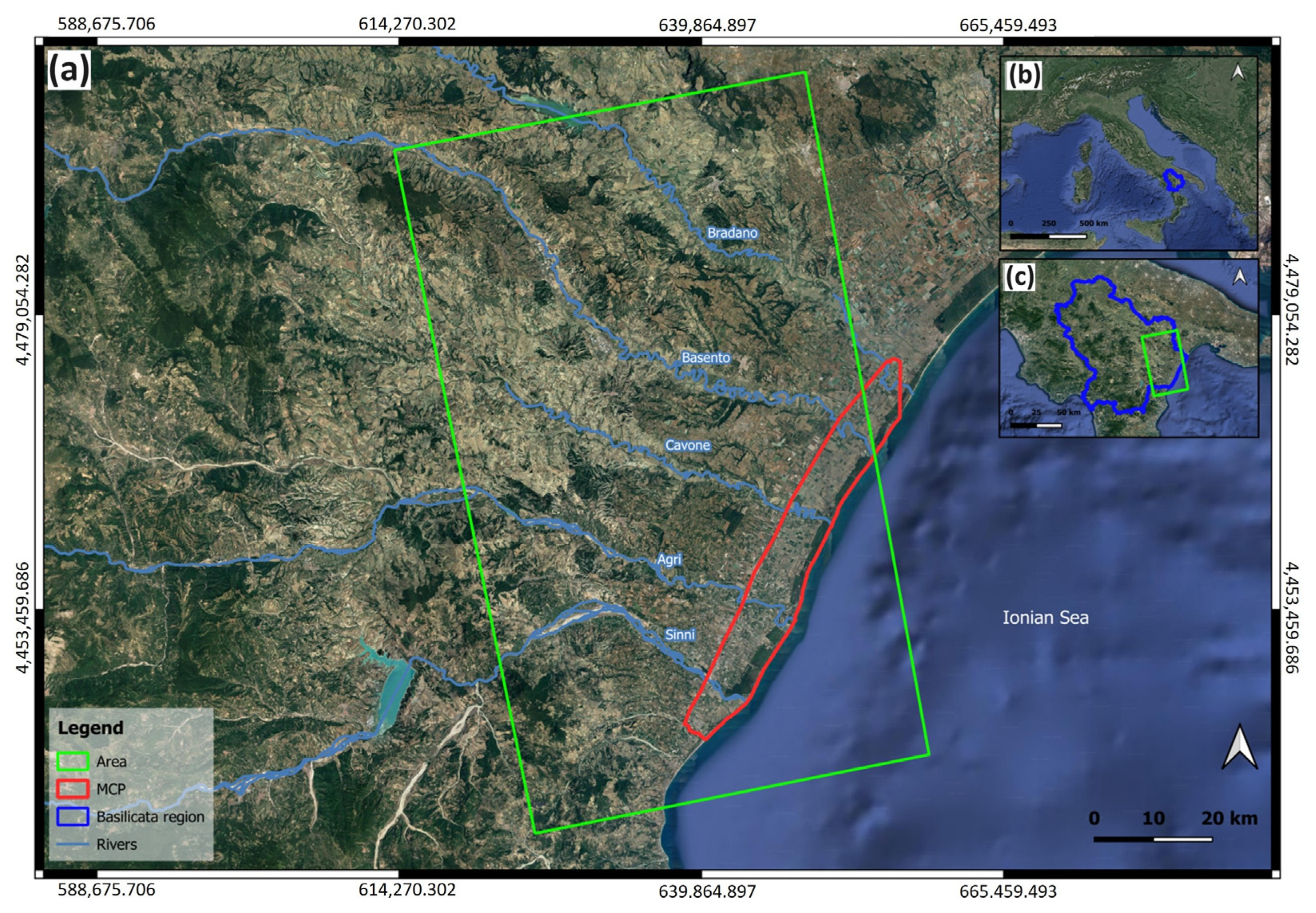

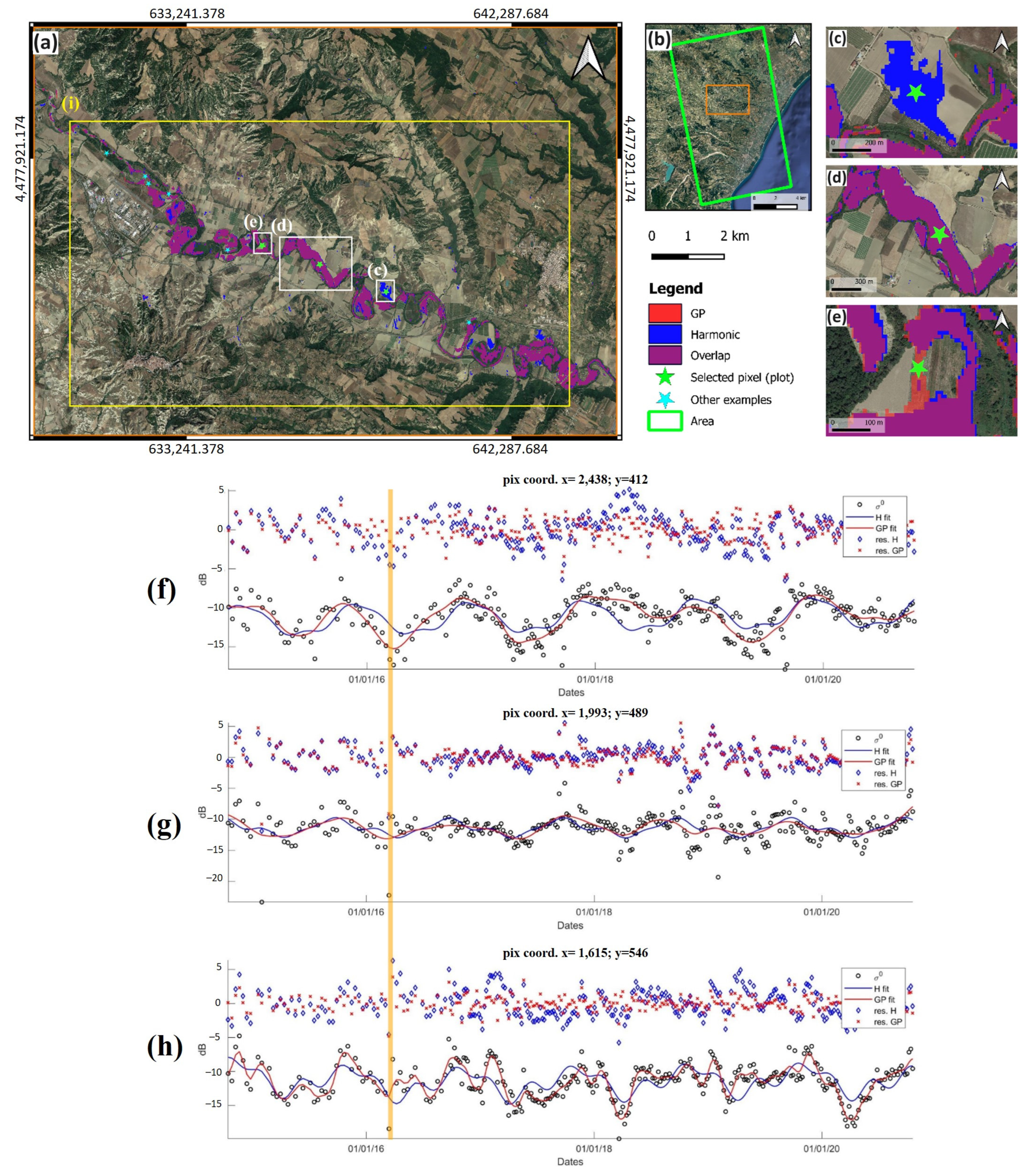
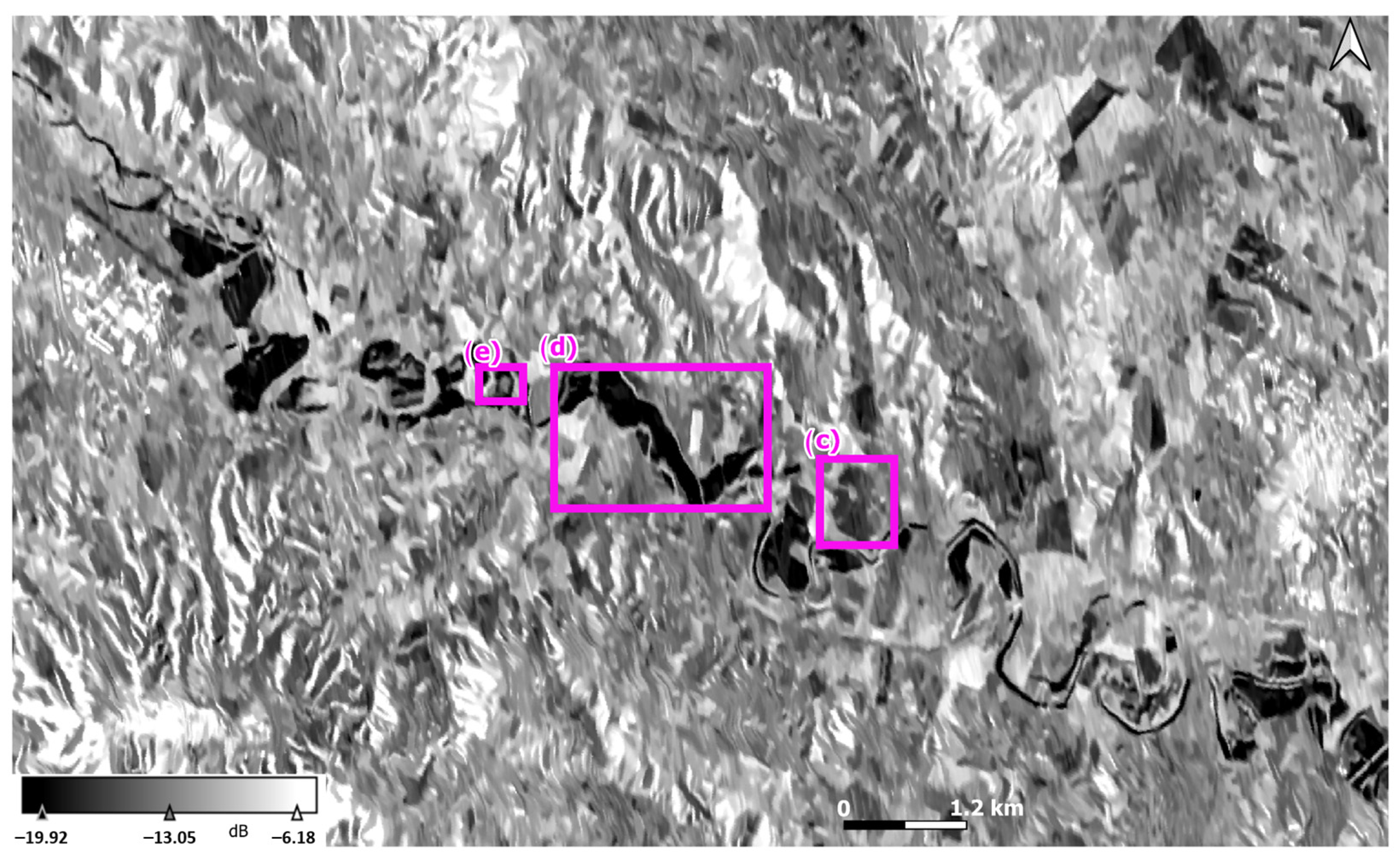
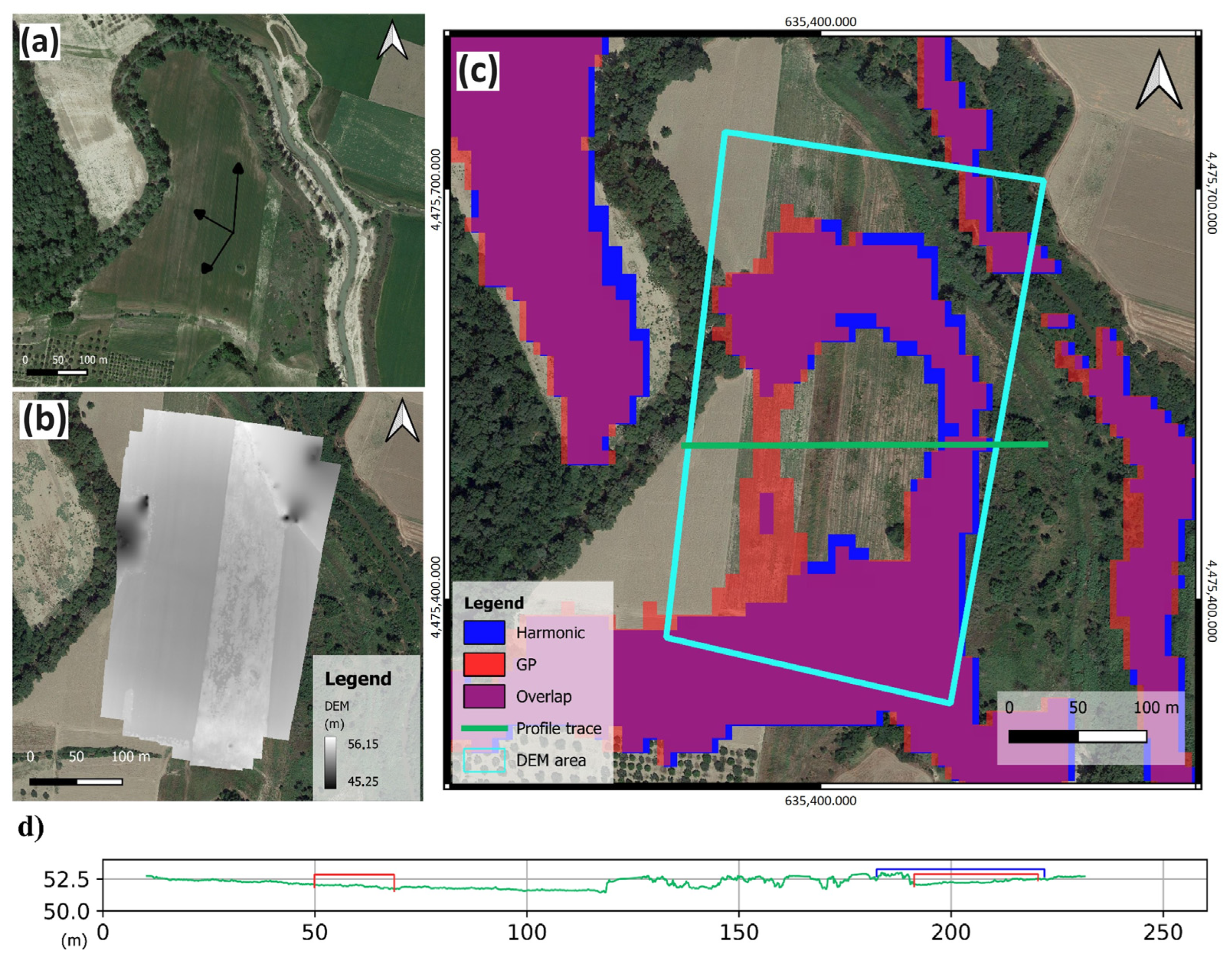
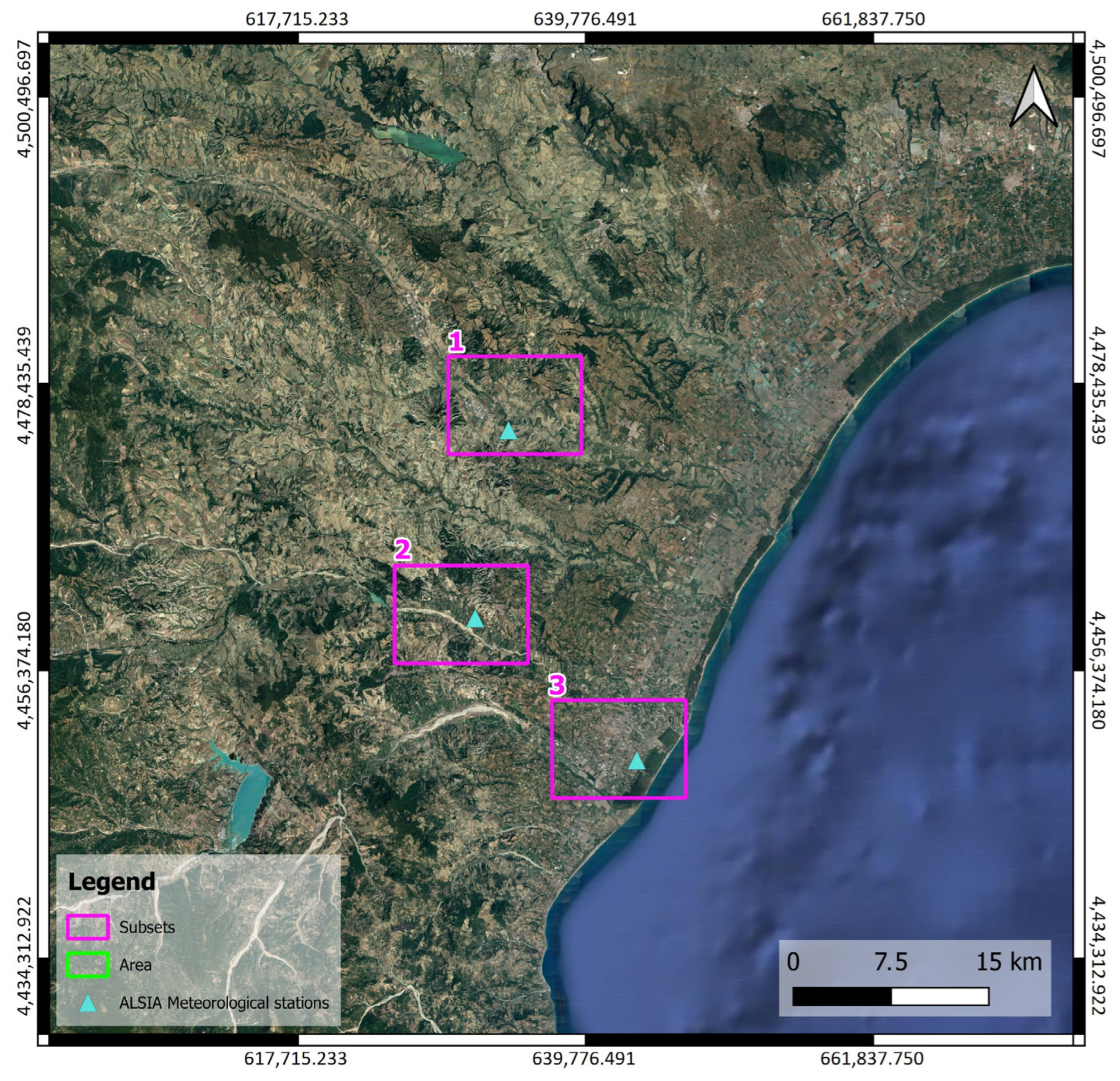
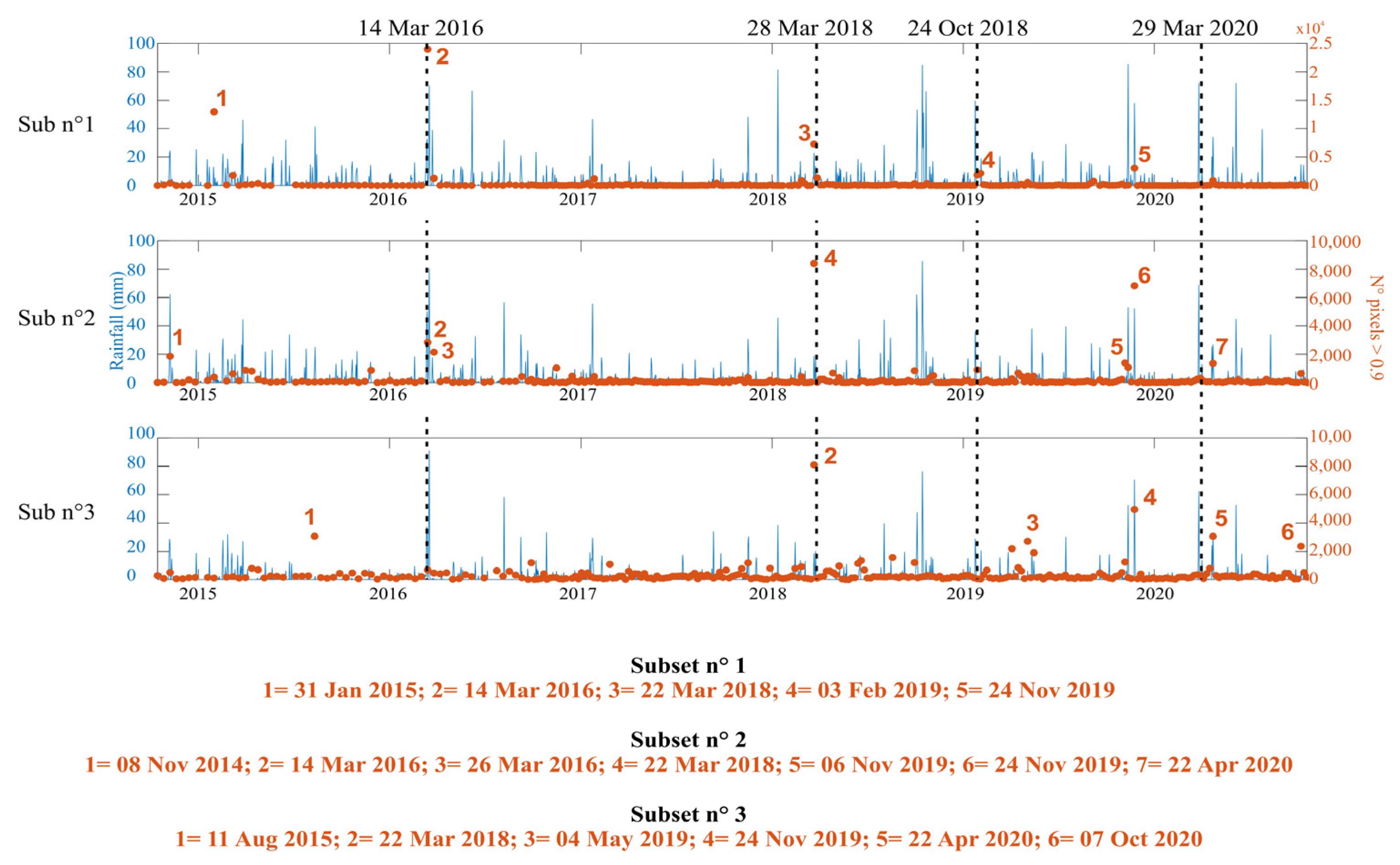
| Year | Dates | River Basins | Description |
|---|---|---|---|
| 2016 | 11–18 March | Bradano, Basento, Cavone, Agri, Sinni | Two intense phases, interspersed with temporary attenuation of the phenomenon. First phase: Basento River floods in the countryside of Pisticci (Scalo and Ponte Accio localities). Closure to traffic of SP154 Tinchi-Bernalda. Second phase: maximum intensity on Sinni basin. (Civil Protection Report). Cumulative rainfall measured in Pisticci Scalo: 171.80 mm. |
| 2018 | 25–28 March | Basento | Basento floods in the countryside of Pisticci, in several areas. The Tinchi-Bernalda provincial road, in Contrada Accio, is closed. Cumulative rainfall measured in Pisticci Scalo: 14.60 mm. |
| 18–23 October | Basento | The Pisticci area is particularly affected: flooding, road closures, and disruption of rail traffic. A total of 100 hectares of land are flooded in Scanzano Jonico as water overflowed from drainage canals clogged with reeds and weeds. Cumulative rainfall measured in Pisticci Scalo: 66.40 mm. | |
| 2020 | 26–27 March | Sinni, Agri, Basento | Flooding of the Sinni River in the countryside of Tursi. Cumulative rainfall measured in Tursi—San Donato: 70.6 mm. |
| Dates | Subset n°1 | Subset n°2 | Subset n°3 | |||
|---|---|---|---|---|---|---|
| N° Pixels | Area (km2) | N° Pixels | Area (km2) | N° Pixels | Area (km2) | |
| 08/11/2014 | 416 | 0.042 | 1857 | 0.186 | 518 | 0.052 |
| 31/01/2015 | 12,971 | 1.297 | 389 | 0.039 | 120 | 0.012 |
| 11/08/2015 | 11 | 0.001 | 48 | 0.005 | 3069 | 0.307 |
| 14/03/2016 | 23,991 | 2.399 | 2833 | 0.028 | 698 | 0.070 |
| 26/03/2016 | 1271 | 0.127 | 2152 | 0.215 | 475 | 0.048 |
| 22/03/2018 | 7300 | 0.730 | 8397 | 0.840 | 8096 | 0.810 |
| 03/02/2019 | 2138 | 0.214 | 30 | 0.003 | 47 | 0.005 |
| 04/05/2019 | 530 | 0.053 | 458 | 0.046 | 2713 | 0.271 |
| 06/11/2019 | 32 | 0.003 | 1387 | 0.140 | 1250 | 0.125 |
| 24/11/2019 | 3081 | 0.308 | 6828 | 0.683 | 4951 | 0.495 |
| 22/04/2020 | 837 | 0.084 | 1357 | 0.136 | 3064 | 0.306 |
| 07/10/2020 | 182 | 0.018 | 646 | 0.065 | 2357 | 0.236 |
Disclaimer/Publisher’s Note: The statements, opinions and data contained in all publications are solely those of the individual author(s) and contributor(s) and not of MDPI and/or the editor(s). MDPI and/or the editor(s) disclaim responsibility for any injury to people or property resulting from any ideas, methods, instructions or products referred to in the content. |
© 2024 by the authors. Licensee MDPI, Basel, Switzerland. This article is an open access article distributed under the terms and conditions of the Creative Commons Attribution (CC BY) license (https://creativecommons.org/licenses/by/4.0/).
Share and Cite
Colacicco, R.; Refice, A.; Nutricato, R.; Bovenga, F.; Caporusso, G.; D’Addabbo, A.; La Salandra, M.; Lovergine, F.P.; Nitti, D.O.; Capolongo, D. High-Resolution Flood Monitoring Based on Advanced Statistical Modeling of Sentinel-1 Multi-Temporal Stacks. Remote Sens. 2024, 16, 294. https://doi.org/10.3390/rs16020294
Colacicco R, Refice A, Nutricato R, Bovenga F, Caporusso G, D’Addabbo A, La Salandra M, Lovergine FP, Nitti DO, Capolongo D. High-Resolution Flood Monitoring Based on Advanced Statistical Modeling of Sentinel-1 Multi-Temporal Stacks. Remote Sensing. 2024; 16(2):294. https://doi.org/10.3390/rs16020294
Chicago/Turabian StyleColacicco, Rosa, Alberto Refice, Raffaele Nutricato, Fabio Bovenga, Giacomo Caporusso, Annarita D’Addabbo, Marco La Salandra, Francesco Paolo Lovergine, Davide Oscar Nitti, and Domenico Capolongo. 2024. "High-Resolution Flood Monitoring Based on Advanced Statistical Modeling of Sentinel-1 Multi-Temporal Stacks" Remote Sensing 16, no. 2: 294. https://doi.org/10.3390/rs16020294
APA StyleColacicco, R., Refice, A., Nutricato, R., Bovenga, F., Caporusso, G., D’Addabbo, A., La Salandra, M., Lovergine, F. P., Nitti, D. O., & Capolongo, D. (2024). High-Resolution Flood Monitoring Based on Advanced Statistical Modeling of Sentinel-1 Multi-Temporal Stacks. Remote Sensing, 16(2), 294. https://doi.org/10.3390/rs16020294










